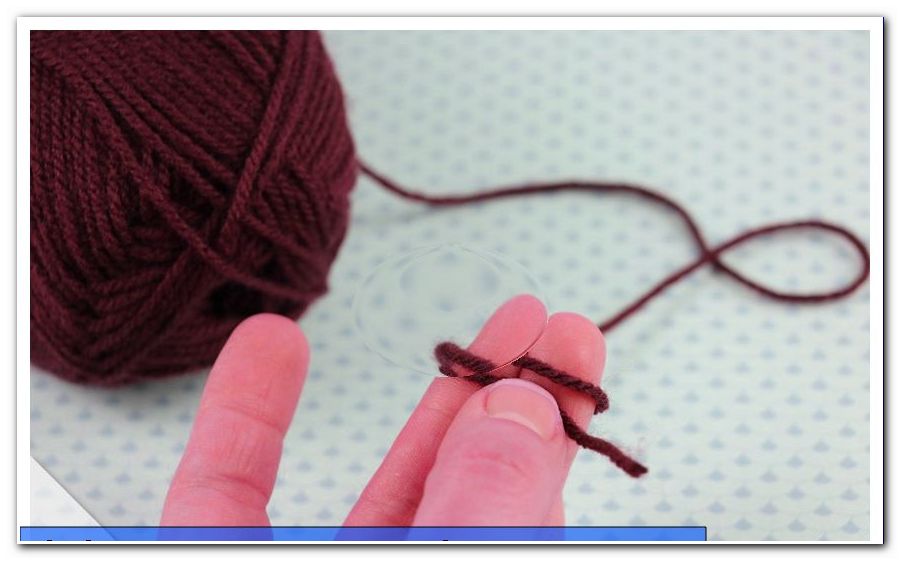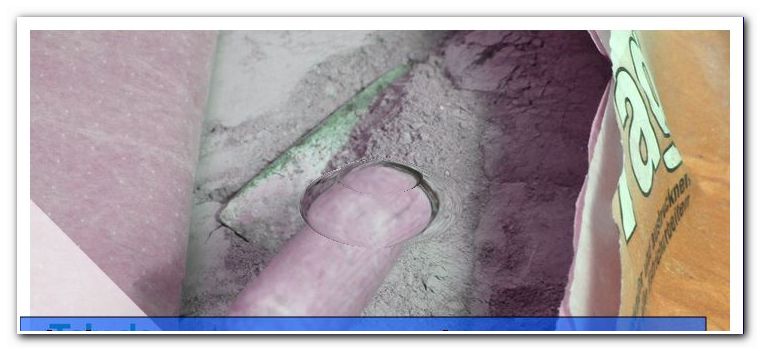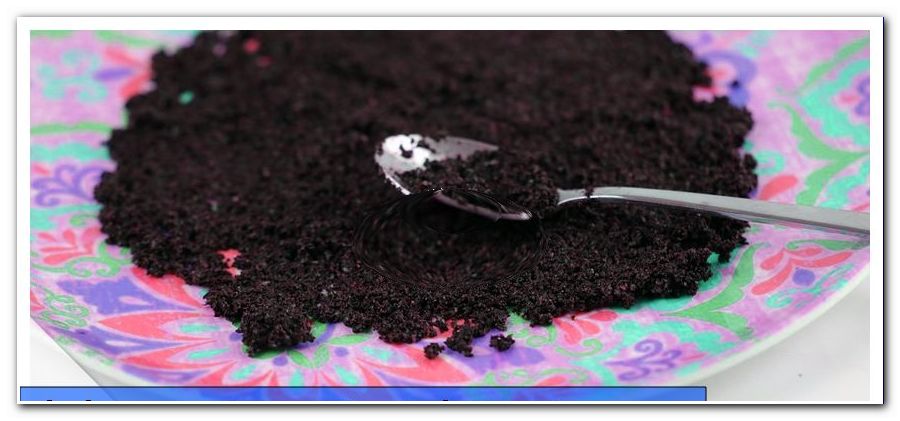Laying pavement - DIY garden path made of paving stones

- Types of garden paths
- Paved garden paths
- construction
- Guide DIY garden path
- Maintain garden path
A practical garden path with a great look. A paved path in the garden not only makes a good impression. Above all, it allows you to cross the garden in any weather. The shoes always stay clean and no dirt is carried into the house. Creating a DIY garden path is a project for which you should plan a Saturday. After that he is ready for decades and defies all seasons, wind and weather. Read in this text everything you need to know about creating a garden path.
Types of garden paths
There are basically two types of garden paths:
- Shattered garden paths
- Paved garden paths
Shattered garden paths are very fast and cheap to produce. They simply consist of a thick layer of gravel or bark mulch. This type has the advantage that it does not compact the soil and can be completely removed quickly and easily. They are visually not very appealing and just as durable. Shattered garden paths are constantly growing. They can be maintained only laboriously by hand.
Paved garden paths, however, are not only shapely and make a professional impression. They are also very durable and usually need not be renewed.

Paved garden paths
As Pflastersorten the willing to build four types are available:
- Natural stone paving
- brick paving
- Concrete pavers
- Concrete paving with local formwork
Making a DIY garden path is identical for the first three types of plaster. The concrete paving with Ortschalung are somewhat lengthy in the production. But they are visually very interesting and very easy to build.
construction
Construction of paved garden paths
A paved path is a construction project like any other.
The path consists of:
- Substructure with drainage and insulation
- foundation layer
- sand layer
- Top layer of paving stones
- lateral support
The substructure keeps the foundation frost-free and dry. The insulation serves to prevent duckweed from forming under the path. Rainwater is discharged laterally through the open-pored structure of the foundation layer. The foundation, consisting of antifreeze gravel or gravel, carries the upper layers, consist of sand layer and top layer. The layer of sand creates a flat, somewhat flexible ceiling. On her the paving stones are laid exactly.
Guide DIY garden path
Garden path made of paving stones - step by step
A garden path is a construction project like any other. It requires careful planning and implementation in order to achieve a lasting, beautiful and efficient result. Read here step by step how to make your garden path made of paving stones a success.

You need to lay pavement in your garden:
- 0.3 m³ of gravel per meter of garden path
- 0.1 m³ of sand per meter of garden path
- paving stones
- patch film
- wheelbarrow
- flat godfather
- Shovel or mini excavator
- broom
- about 1 bucket of quartz sand per 2 meters way
- Roof battens, string and earth color

1. The planning
Carefully plan the course and the width of your garden path. Also think of junctions that you might want to realize later. The space in a garden is always limited. Therefore, do not build a "motorway" - but a path that is beautiful and functional, yet as narrow as possible.
A path in the garden is particularly appealing when it is curved . If the size of your garden allows for such a course, then test it. Take a picture of her garden and trace different patterns until you find the most beautiful and practical profile.
For the width you can orient yourself according to the following guidelines:
- Off the road to the house entrance: 1.20 - 1.50 meters
- Path to the terrace or garden shed: 0.8 meters
- Path to the compost pile or flowerbed: 0.4 meters
The road to the road is used most often. In addition, all furniture is transported through him, which should be in the house. Therefore, this path should be wide and straight. A path to the terrace or garden shed should be so wide that two people can walk side by side. The way to the compost heap, to the flowerbed or other, less frequently visited places in the garden, can therefore be chosen very narrow.

Another measure is the distance to hedges, walls, groves or border fences. With about 30 cm you have enough freedom of movement to pass the way comfortably.
2. The Schnoor stand
The planning is finished, now it is time to build. For this purpose, a Schnoorüst will be built along the planned path. Start with a page first. Then measure the width and set the piles facing each other. The batter board marks the exact course of the path. In addition, the height of the cord dictates the top of the patch. The string can be set a little higher. But it should always be straight or run parallel to the soil profile. Along the string the course is sprayed with earth color.
3. Excavation
First, the turf is removed. This is done along the width of the way plus about 20 cm wide away. A depth of 50 cm excavation is required to produce the necessary frost protection. Frost can destroy a garden path quickly, then the laborious pavement was laid bare for nothing. You prevent this by observing the minimum depths when excavating. Depending on the length of the garden path, a mini excavator can be helpful here.

4. Pave the pit
It is recommended to level the excavation pit once with a rammer. The soil becomes firm and sustainable.
5. Folate
Now frost protection film is designed. The overlap of the individual webs should be at least 30 cm, ideally 50 cm.
6. Set limit
Paving stones need lateral support so they do not slip off over time. For this the trade offers lowboards or L-stones. They are set before the gravel bed is laid out. However, there are also limitations in the form of plastic angles . These are only set when the gravel and sand beds are laid. This makes laying the paver much easier.
7. Lay out the gravel bed
As a foundation mass looser, binder free antifreeze gravel or gravel is used. Concrete is unsuitable because it would be very difficult to build back again. If the plans for the property change, the gravel can simply be dredged away again. As a thickness 10 cm are a minimum, optimal are about 30 cm . The gravel bed is evenly distributed and then also compacted with rammer or vibrating plate .
Along the way, a slope of about 2 ° should be created so that rainwater can drain. For this you can orient yourself on the Schnoor. A slope of 2 ° means a fall in the soil profile from 2 meters to 100 meters in length or 2 cm per meter of garden path. If you want to work with plastic brackets for lateral support, inserting the elements is the last step of reasoning.

8. Lay sand bed
On the gravel bed comes a sand bed of about 10 cm thickness. It gives the base coat a straight, clean finish and makes it ready to pick up the paving stones.

9. Lay stones
The stones are laid dry in bursts. When laying, make sure that you do not form cross joints . Penetrating water and vibrations through walking make it easier to loosen the stones. Pay attention to an absolutely level top layer. With a rubber hammer, the paving stones can be lowered even more. Here you have to be very correct when laying the paver, otherwise you will risk stumbling blocks.

10. One
The interstices of the paving stones are filled up with fine quartz sand . First, the sand is distributed and then swept into the joints. If rainy weather is announced, you should leave the sand for a few days on the garden path made of paving stones. The rain then ensures that the quartz sand is flushed into your DIY garden path. Subsequently, the excess quartz sand is turned away. You can also rinse the sand with a garden hose.
Maintain garden path
A paved path weathers over time. Dust and moss clung to him. These can be removed very well with a high-pressure cleaner. However, usually the sand filling is flushed out of the joints. If you want to give your paved path a thorough cleaning, then re-calculate the subsequent Einsanden .




